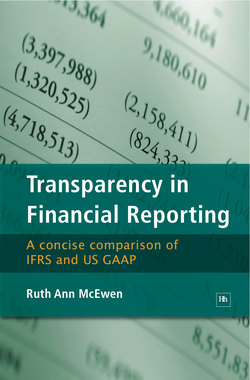Оглавление
Ruth Ann McEwen. Transparency in Financial Reporting
Copyright
About the author
Introduction
Part One: Transparency of Financial Reporting
1. Transparency and Financial Reporting Quality
2. Transparency of the Balance Sheet: Fair Valuation. A. Fair valuation under alternative market assumptions
B. Hierarchy of inputs
C. Hierarchy of inputs: example
D. Entity-specific estimates
Part Two: Financial Reporting under IFRS Convergence
3. Legal Basis of US GAAP and IFRS. A. Common law versus code law
B. The codification
4. Fundamental Similarities and Differences
Part Three: Technical Analysis: US GAAP versus IFRS
5. Presentation of Financial Information
A. Balance sheet items
B. Income statement items
Extraordinary items
C. Comprehensive income, earnings and earnings per share
D. Statement of cash flows
E. Interim and segment reporting
F. Assets held for sale and discontinued operations
G. Capital
H. Stockholders’ equity
I. Notes
6. Related Party Transactions
7. Subsequent Events
8. Revenue Recognition
A. Bill-and-hold sales
B. Long-term construction contracts
C. Software
D. Multiple deliverables
E. Disclosure
F. Differences in revenue recognition
9. Assets
A. Inventory
B. Biological assets
C. Plant, property and equipment
Interest capitalization (borrowing costs)
Figure 9.1: Schedule of weighted average accumulated expenditures and avoidable interest
Depreciation
D. Investment property
E. Leased assets
Figure 9.2: Lessor’s calculations
Figure 9.3: Lessee’s calculations, guaranteed residual value
Figure 9.4: Lessee’s calculations, unguaranteed residual value
F. Basket purchases and bargain purchases
G. Investments in securities and the equity method
H. Asset retirement obligations
I. Intangible assets
10. Asset Impairment
11. Liabilities and Contingencies. A. Current liabilities
B. Loss contingencies
C. Provisions, contingent liabilities and contingent assets
12. Pension Obligations and Expenses
Service cost
Interest on the liability
Expected return on the plan assets
Actuarial gains and losses
Figure 12.1: Memo accounts of Smith Company
13. Financial Instruments
14. Derivatives and Hedging
15. In Process Research and Development (IPRD)
16. Share Based Payments
17. Restructuring
18. Business Combinations
A. Consolidated or separate presentation
19. Income Taxes
Figure 19.1: Income for financial reporting
Figure 19.2: Income for treasury reporting
Figure 19.3: Smith’s entries
Part Four: First Time Adoption: IFRS 1
20. Asset Differences
21. Mandatory and Optional Exemptions
A. Mandatory exemptions. Derecognition of financial instruments
Hedge accounting
Estimates
Assets classified as held for sale and discontinued operations
Non-controlling interests
B. Optional exemptions
Business combinations
Fair value or revaluation as deemed cost
Employee benefits
Cumulative translation differences
Compound financial instruments
Assets and liabilities of subsidiaries, associates and joint ventures
Designation of previously recognized financial instruments
C. Other adoption considerations
Risks associated with conversion
Conclusion
Articles
Websites
Отрывок из книги
Ruth Ann McEwen is Associate Dean of Accreditation and Administration and Professor of Accounting for the Sawyer Business School at Suffolk University. She earned her Ph.D. in Industrial Management with a concentration in Accounting from the Georgia Institute of Technology and taught Financial Accounting at the Master’s and Doctoral levels for more than 20 years. She is the author or co-author of more than 40 refereed articles and proceedings focusing on the usefulness of accounting information. She has published in such premier journals as The Accounting Review, Decision Sciences, Accounting Horizons, CPA Journal, International Journal of Accounting and the Journal of Business Ethics and is the author of “Earnings Per Share” and co-author of “Asset Retirement Obligations” published by Tax Management, Inc. In 1998, she presented a series of research papers to a joint seminar of the Financial Accounting Standards Board (FASB) and the Governmental Accounting Standards Board (GASB) focusing on current financial reporting.
From 2005 until 2008, Ruth Ann McEwen served as a consultant to the FASB, authorized as a content expert to codify United States Generally Accepted Accounting Principles (US GAAP), which comprises authoritative guidance for US corporate financial reporting. She has received numerous scholarly, teaching and research awards.
.....
11 http://fmcenter.aicpa.org/Resources/Traditional/Quality+of+Earnings+Case+Study+Collection.htm [return to text]
Under FAS 157, Smith should maximize the use of observable inputs when possible. In the current setting, estimating the liability requires Smith to estimate a subjective probability distribution for each of a series of questions addressing the likelihood of defending the patent and estimates of future cash flows. For example, Smith might estimate: (1) the probability of defending the patent, (2) market sales once the patent issue has been resolved, (3) the probability that Product A will become technologically obsolete, and (4) the probability that future patent actions may reduce sales.
.....
